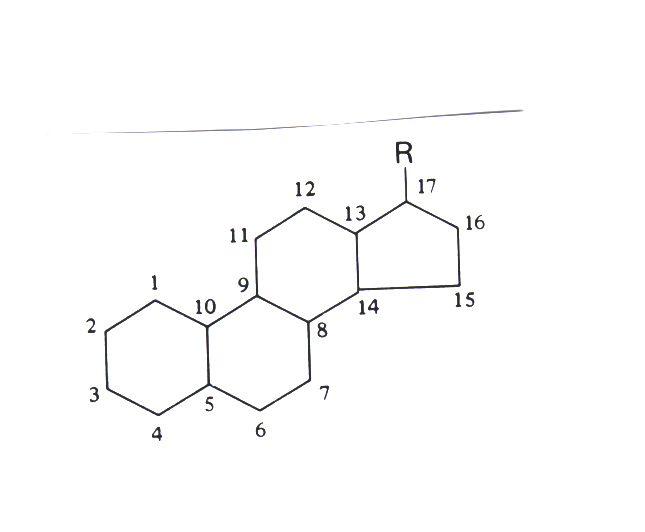
Monogastrics
Source of CHO: plant starch & animal glycogen
Breaks down to glucose
Digestion & Absorption?
Small IntestineGlucose goes to the liver via hepatic portal vein
In the liver
Ruminant
Source of CHO:
Primarily starch and celluloseAnaerobic fermentation in rumen!
Starch & cellulose
Type of Diet:
High cellulose = increase rumen acetate = milkfat
High starch = increase rumen proionate = gluconeogenic
Anaerobic Rumen:
No O2
No electron acceptor
No electron transport
Goal is to regenerate NAD (drives glycolysis and krebs), but in Rumen??
NAD's transfer to pyruvate to form lactate
2 ATP's produced in rumen glycolysis, instead of 6 in cells
CO2 serves as terminal electron acceptor CO2
Glucose
® lactate ® propionate
® butyrate
® acetate
Lactate build-up in the rumen:
Lactic acidosis
Acidosis
Grain overload
Laminitis
founder
Cause=
abrupt increase in starch intake, increases lactate procuction, decreases rumen pH (6.8 ® 5.0).Occurs when taken from pasture (roughage) and immediately placed on high CHO (corn) diet.
Question?? Acidosis?? Rumen Sample of:
|
Propionate = |
20% |
|
Butyrate = |
10% |
|
Acetate = |
70% |
Not acidosis, propionate from lactate, increase acetate = high forage diet, not a lot of starch
Look at Pro:Ace ratio WHY?
1. Acetic acid
® lost as CH4 = wastefull2. Propionate
® less CH4 more DE trapped as ME!Factors that Alter Rumen Fermentation
1. Type of CHO
= starch increases propionate, cellulose increases acetate.2. Feed additives
= ionophores, alter Pro:Ace, better utilization of feed. A type of antibiotic = selectively inhibits acetate producing microbes.monensin = Rumensin
lasalocid = Bovatec
3. Total VFA Produced
a. physical form = ground VS. cracked corn = surface area
b. type of CHO = cellulose VS. starch
VFA Metabolism
Acetate
® Acetyl CoA = no gluconeogenesisButyrate
® 2 Acetyl CoA = no gluconeogenesisPropionate
® succinyl CoA = gluconeogenesisVFA's for energy:
Acetate, Propionate, ButyrateVFA's for Fatty Acid synthesis (Ketogenic):
Acetate, ButyrateVFA's for glucose synthesis (Gluconeogenic):
PropionateBlood Glucose Concentration
Monogastric
~90 - 100 mg.dLRuminant
~40 - 60 mg/dLDifference is because little free glucose absorbed in G.I. tract of ruminant, process of synthesizing glucose = gluconeogenesis.
Gluconeogenesis
= glucose synthesis from non-CHO sourcesPropionate
Lactate
Glycerol
Some A.A.
3 Irreversable Reactions of Glycolysis:
(otherwise = glycolysis backwards)1.
PEP ® pyruvate Þ pyruvate ® oxaloacetate ® PEP2.
Fructose-6-phosphate ® Fructose-1,6-bisphosphate Þ use different enzyme3.
Glucose ® Glucose-6-phosphate Þ use different enzyme
LIPIDS
General: organic compounds that contain C, H, O
Carbohydrates = CH2O
Lipids = more reduced = more H, less O2
More reduced = more energy dense: 2.25 X more (9/4=2.25)
Most feeds contain less than 5% fat
Humans = ~18% fat : 18X 2.25 = 40% calories from fat.
* Ideal = < 30% calories should come from fat, animals not a problem, low fat diet anyhow.
Structure:
CH3(CH2)X
-COOHNon-polar, H3O insoluble
Carboxylic acid = polar, H3O soluble
Short chain:
less than 14 carbons
2 |
acetate |
CH3COOH |
3 |
propionate |
CH3CH2COOH |
4 |
butyrate |
CH3(CH2)2COOH = CH3CH2 CH2COOH |
Medium and long chain:
Almost all have even number of carbons
Most fatty acids are long chain
Saturated FA:
No double bond C (no p bonds) General formula = CH3(CH2)XCOOHmyristate |
C14:0 |
palmitate |
C16:0 |
stearate |
C18:0 |
Unsaturated FA:
palmitoleic |
C16:1 |
oleic |
C18:1 |
linoleic |
C18:2 |
linolenic |
C18:3 |
arachidonic |
C20:4 |
Essential FA:
Can not be synthesized by the body, therefore dietary requirement
linoleic
linolenic
arachidonic (the cat can not synthesize)
Dietary From:
Triglyceride (TG):

Di-:
glycerol + 2 fatty acidsMono-:
glycerol + 1 fatty acidPhospho-:
glyceride + 2 fatty acids + phosphateGlyco-:
CHO groupSulfo-:
SO4Lipoprotein:
contains protein1.
low density lipoprotein (LDL) = lipid, ¯ protein (bad cholesterol)2.
high density lipoprotein (HDL) = ¯ lipid, protein (good cholesterol)Other Lipds
Waxes:
Steroids:
insoluble in water*basic structure

Cholesterol
- precursor for sex hormonesCarotenoids
- carotene - yellow pigment of veggies (Vit. A precursor)